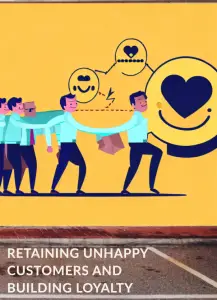Any successful company is built on the foundation of satisfied customers. Even the most attentive businesses, nevertheless, sometimes deal with dissatisfied clients.
How can I effectively engage with unhappy customers?
Engaging with unhappy customers requires active listening, empathy, and a genuine desire to resolve their concerns. By addressing their issues promptly and offering personalized solutions, you can turn negative experiences into positive outcomes.
The key lies in how you engage with these dissatisfied customers and turn their negative experiences into positive ones.
In this article, we’ll delve into effective strategies and real-life case studies on engaging with unhappy customers, transforming challenges into opportunities for growth.
The Power of Effective Customer Communication

One of the first steps in handling unhappy customers is through open and empathetic communication. Learn how to respond to complaints, address concerns, and demonstrate genuine care for your customers’ issues. Discover the art of active listening, and explore real-world examples of businesses that have mastered the art of communication, leading to improved customer relationships.
Learning from Real-Life Case Studies

Case studies provide invaluable insights into successful customer issue resolution. Delve into inspiring stories of companies that managed to turn unhappy customers around. Analyze their strategies, understand their thought processes, and find out how they implemented solutions that not only resolved the issues but also enhanced customer loyalty and trust.
Retaining Unhappy Customers and Building Loyalty

Turning unhappy customers into loyal brand advocates is a skill worth mastering. Explore proven methods for retaining dissatisfied customers, and learn how to transform their negative experiences into lasting loyalty. Discover the importance of empathy, effective problem-solving, and personalized solutions that cater to individual customer needs.
Navigating Online Reputation Management

In today’s digital age, online reviews and feedback can significantly impact your brand’s reputation. Discover the art of managing negative customer feedback and reviews effectively. Learn how to address complaints, restore trust, and maintain a positive online presence. Through practical strategies and real-world examples, you’ll gain insights into safeguarding your brand’s image.
Utilizing Customer Feedback for Business Improvement

Customer feedback is a treasure of knowledge that may fuel company growth. Investigate methods for gathering, evaluating, and using consumer input to improve your offerings to customers overall. Learn how innovative companies use consumer feedback to guide innovation, inform choices, and remain one step ahead of the competition.
Mastering Conflict Resolution and Service Recovery

Conflicts are inevitable, but they can be transformed into opportunities for growth. Dive into effective conflict resolution techniques that not only address customer concerns but also lead to mutually beneficial outcomes. Learn how to de-escalate tensions, find common ground, and turn mistakes into chances for exceptional service recovery.
Elevating Customer Satisfaction for Business Success
At the heart of it all, customer satisfaction drives business success. Explore comprehensive strategies for elevating customer satisfaction and enhancing the overall customer experience. From improving dissatisfaction to creating memorable moments, discover actionable steps to ensure your customers remain not just satisfied, but delighted.
Conclusion
In conclusion, engaging with unhappy customers is not just about resolving complaints; it’s about transforming negative experiences into opportunities for growth and improvement. By mastering effective communication, learning from real-life case studies, and implementing strategic approaches, businesses can not only retain dissatisfied customers but also create lasting loyalty and positive brand perception. Dive into this article to uncover the secrets of engaging with unhappy customers and turning them into your most loyal advocates.
FAQ’s
What role do case studies play in customer issue resolution?
Case studies provide real-life examples of successful customer issue resolution. They offer insights into strategies, techniques, and thought processes that businesses have used to transform unhappy customers into satisfied ones.
How can I retain dissatisfied customers and build loyalty?
Retaining dissatisfied customers involves acknowledging their concerns, offering swift solutions, and demonstrating a commitment to improvement. By showing empathy and delivering exceptional service recovery, you can build loyalty and turn these customers into brand advocates.
How do I manage negative customer feedback online?
Managing negative customer feedback online requires a strategic approach. Respond promptly, address the issues professionally, and offer solutions publicly. Demonstrating a willingness to resolve problems can help restore trust and maintain a positive online reputation.
What are the benefits of utilizing customer feedback for business improvement?
Customer feedback offers valuable insights into areas for improvement. By paying attention to your clients, you can pinpoint their needs, improve your goods and services, and maintain your position as a market leader. Making use of feedback may promote innovation and corporate expansion.
What’s the key to effective conflict resolution and service recovery?
Effective conflict resolution involves active communication, finding common ground, and mutually beneficial solutions. Service recovery requires acknowledging mistakes, taking ownership, and going above and beyond to rectify the situation, rebuilding customer trust and loyalty.

